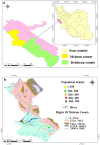Study of fauna, activity patterns and Leishmania infection rate of phlebotomine sand flies in Western Iran
- PMID: 33746413
- PMCID: PMC7921254
- DOI: 10.1007/s12639-020-01298-2
Study of fauna, activity patterns and Leishmania infection rate of phlebotomine sand flies in Western Iran
Abstract
Cutaneous leishmaniasis is a crucial vector-borne disease caused by various species of Leishmania and is transmitted by several species of sandflies. The present study was conducted to describe sand fly fauna on vectors of leishmaniasis and performing molecular identification of Leishmania isolates from them on the Iran-Iraq border. Entomological surveys were done from May to October 2016-2018 in 2 counties (Mehran and Dehloran) of Ilam province, west of Iran. Sandflies were collected by 40 Sticky Traps at each station. Samples were mounted for species identification using morphological characters of the head and abdominal terminalia. DNA was extracted from Phlebotomus papatasi females, and Leishmania isolates were identified through PCR on minicircle kDNA, followed by sequencing. A total of 5592 sandflies including 2 genera of Phlebotomus and Sergentomyia comprising 8 species of sand flies were detected. Leishmania major infection was detected in 3.33% of 300 tested female sandflies. Phlebotomus papatasi was predominant in outdoor and indoor resting places. Phlebotomus papatasi was determined as dominant vector of Leishmania major infection in Mehran and Dehloran counties, West of Iran. It seems the composition of sandfly species in the study area is almost similar to the other parts of Iran. A detailed description of the epidemiology and ecology of Phlebotomine sand flies needs to be established to accomplish effective vector control programs.
Keywords: Iran; Leishmania; Phlebotomine; Psychodidae; Sand fly.
© Indian Society for Parasitology 2020.
Conflict of interest statement
Conflict of interestAll authors declare that there are no conflicts of interest.
Figures




References
-
- Afshar AA, Rassi Y, Sharifi I, Abai M, Oshaghi M, Yaghoobi-Ershadi M, et al. Susceptibility Status of Phlebotomus papatasi and P. sergenti (Diptera: Psychodidae) to DDT and Deltamethrin in a Focus of Cutaneous Leishmaniasis after Earthquake Strike in Bam, Iran. Iran J Arthropod Borne Dis. 2011;5:32–41. - PMC - PubMed
LinkOut - more resources
Full Text Sources
